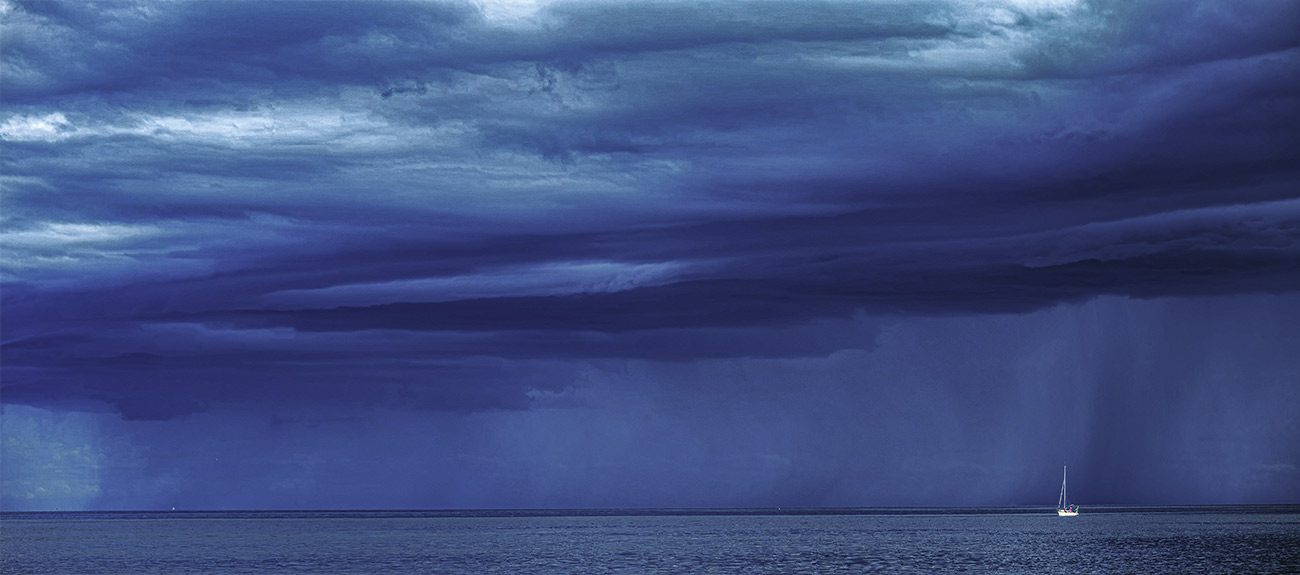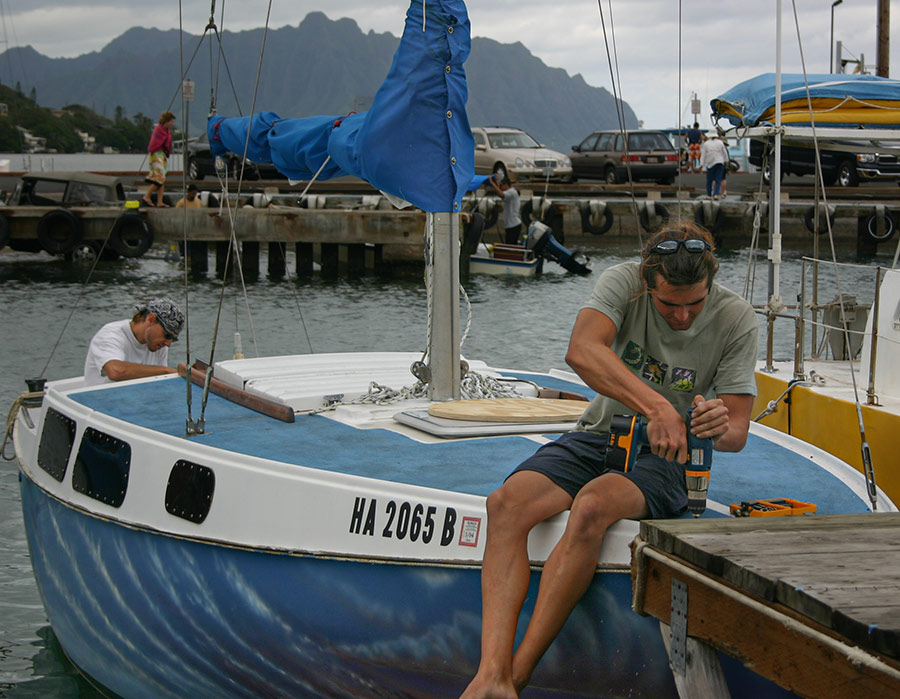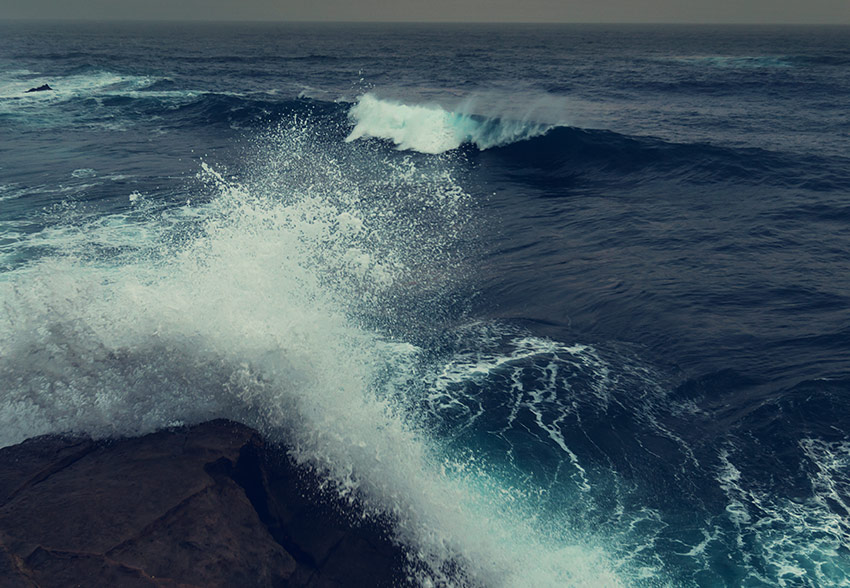An Account of Survival at Sea

Hello everyone. I’m Rob.
This is my personal account of sinking my sailboat at sea. It was an event that changed me. To make this more accessible, I’ve recorded my account here and the text follows.
It may happen one day – It happened to me!
There’s something about almost dying that changes you. At age 23, a violent storm sank my boat a couple miles offshore in Hawaii. I struggled for my life for 3 hours in turbulent, shark-infested waters. When I was at my most vulnerable, watching my sailboat disappear under the waves, I learned something that not only changed the way I see our one precious life – but it changed my relationship with the natural world.
The swim that changed me
I was studying to get a Phd in marine biology at University of Hawaii, Manoa. Hawaii is an expensive place to live, so I got creative and figured out how to get by – purchase a $900 rusty old sailboat and live on it. So I became the owner of a small 20’ house with sails. I couldn’t afford an instructor, so I got the next best thing – “Sailing for Dummies.” Mind you, I knew how bad/embarrassing it looked reading it on the deck of my boat for all the world to see, so I either read it at night or disguised in another book’s cover.

I felt like I was a pretty quick learner, and I had many adventures on that sailboat. Some of the more memorable included beautiful and peaceful encounters with tons of marine megafauna – imagine whales breaching close enough to touch. I was living the dream… until I wasn’t.
One morning, my friend asked if we could go sailing on the open ocean. She knew nothing about sailing, and I’d only had the boat a few months. I was woefully unprepared (Sailing for Dummies, ahem), but that didn’t stop me from saying yes. I had gained some confidence on the water, and we naively thought it would be a fun adventure to learn the ropes together.
We took off that morning in strong winds and in what seemed like really big waves for the calm bay we were in. What I didn’t realize is that we were sailing into the storm of the decade – and I hadn’t even bothered to check the weather!
As we exited the relative protection of the bay through the channel that cut between the reefs, the waves were much bigger than I was expecting. I didn’t decide to turn around until I was fully out of the channel. The problem was that the channel had closed out just as we exited. That meant, the massive waves were now breaking in the channel. A breaking wave is far more tricky to navigate than rolling waves. Essentially we didn’t have a way back!
Looking back toward the island, there was nothing but white foam as far as the eye could see. I didn’t know my way back – my navigation skills were weak at this point. I wasn’t prepared for re-entering a channel like this, but I had to try.
I turned the boat toward home and knew our best chance was going to be using the engine to plow our way back through the waves. I pulled the string to start the engine only to find the motor was flooded and dead. I’d have to navigate a return home only with my somewhat awkward skills with the sails – and with a person who knew less about sailing than I did.
I tried to sail back into the channel, turning the boat with each wave to hit it head-on. That worked for a few waves. Then, one fateful wave hit us sideways and swept me off of the boat. Now, I was 2 miles offshore in a storm, looking at my boat sailing away as my friend held onto the rigging on the side. I screamed and swam with all my energy but I couldn’t get to the boat.
Neither of us was wearing a lifejacket. I felt the full weight of my clothes and was struggling to stay afloat. Among the crashing waves, I caught a glimpse of my friend feet in the water yet still holding onto the boat .
She was somehow able to climb back on, but now she was on a runaway sailboat, heading toward the 15-20’ breaking waves on the sides of the channel.

Then the unthinkable happened. As I floated there, I watched my 20’ sailboat, with my friend on the bow, get tossed like a rag-doll end over end in the breaking waves. I knew in my gut there was no way anyone could survive that. One second it was there – and in the next, the boat had snapped in two and sunk. Everyone and everything was gone.
I tried to swim towards the boat, now maybe 1/4 mile away, but it didn’t take many 15’ waves to realize I was going to drown if I kept going that way. I turned and started swimming back to the relative safety of the channel. I was a competitive open water swimmer at that stage in my life, so I felt I could swim the 2 miles to shore if I had to. So I put my head down, took off the rest of my clothes (minus my boxers which I tied around my ankle) and started swimming.
Forty-five minutes into my swim, I realized that the buoys that I should have been passing were doing something funny. Mind you, there was a torrential downpour. Salt was stinging my eyes so it was hard to see the shore, but it struck me that I had been looking at the same buoy this whole time!
I hadn’t been getting closer to shore, I was being swept out to sea. At that point, I saw there was one bouy left. It was my only chance. If I didn’t make it to that buoy, I was a dead man. I would be swept out to sea to drown in a storm in the middle of the ocean. Not good.
I could see it. It was right there, but it took another 20 minutes of swimming as hard as I possibly could to get to that massive, 20’ beast of a marker. Somehow I got on it and held on for 2 hours as the wind and rain pelted my mostly-naked body (I had put those boxers back on).
Anything I would have used to contact or signal for help was all on the boat. The phone, emergency beacon, whistles and flares were all useless now. But, I knew I was on a navigation marker leading out from the Naval base onshore. I thought to myself, what if they’re somehow listening. So, I broke a piece of metal from the navigation buoy and started pounding S.O.S. in morse code on the channel marker, hoping the Navy station nearby might hear it. (FYI – this is how you do that. Three short taps, three long, three short. Easy!)
No one heard my SOS signal, but as fate would have it, a buddy of mine who knew I was heading out to sea that day hopped in his outrigger-canoe to check on us. As he paddled out, he found my friend floating on a lifejacket that had emerged from the boat wreckage. They were able to flag down the only other boat on the channel and a cell phone to call in the emergency!
Three hours into this ordeal, I was naked, afraid, thinking I had killed another person through my ignorance, and suffering from mild hypothermia. The rain was so heavy I couldn’t see the shore, and it was so loud that I doubted myself when I started hearing the sound of helicopters and boats.
Once they spotted me, a jet-ski equipped with surf-saving boards on the back was deployed by the Naval base nearby. I climbed to the top of the buoy, waving and yelling!
The storm was still in full force. Even though they could see me, I still had to find a way to jump to the rescue vessel in between the huge waves that were pounding the buoy. Miraculously, I was able to leap and grab on with enough time to speed away before the next wave clobbered us. 10 minutes of ups and downs that felt like a roller coaster ride got us inside the bay. It was then that they slowed down to tell me my friend was safe. I felt an overwhelming sense of gratefulness and relief. We were alive. We had survived.
After that day, I viewed the world differently. I was in awe of its power – not as an adversary, but knowing I am a part of this thing we call nature. It was an awakening of mortality for a starry-eyed kid who lived and breathed a life of longing to return to the wild, and I have carried this feeling with me into a lifetime of adventures ever since.
I learned respect for what I cannot control, how to weigh and minimize risk in the places I love most (the great outdoors), how to prepare for the unknown, to become “Captain Safety” for myself and others… and I definitely learned to check the weather!
Life after the wreck
After the wreck, I didn’t slow down. I continued to accrue enough adventures to fill many lifetimes. I got a few science degrees, went to film school, met the amazing woman who became my partner in life and filmmaking (Haley), and we started our family. We’ve been around the world filming wildlife in virtually every environment from alpine peaks, rainforest canopies, to hidden caves, African savannah, the deep sea in a homemade submarine, and even the Chernobyl exclusion zone. You can see some of our work on Science Channel, Discovery, Nat Geo, Smithsonian, PBS and Animal Planet, and you can find most of my short-form science stories on my Youtube Channels – STONEAGEMAN and UNTAMED SCIENCE.
Through this work, I have had the absolute pleasure of working alongside biologists who are at the top of their field – who know their study animals and plants better than anyone in the world. I am forever thankful for this gift of knowledge – and the trust they put in me to tell the world the story of their life’s work.
This line of work also brings with it a wealth of stories about plant and animal encounters that did not go well, and we can learn from them. Fortunately for you, I’ve almost died a few times and my life seems to be riddled with friends and colleagues who have survived the craziest of circumstances with animals in the wild. In researching the survival stories you will read in this book, I didn’t have to go far to find many of them. My roommate in grad school survived a grizzly attack and has a scar across his nose to prove it, and an ex-girlfriend now sports a handful of crocodile tooth scars across her chest. I have a buddy who lost an arm and a leg to a bull shark. And the list goes on.
All of these events are extremely unlikely to happen, yet here I am with a deep trove of stories. At this point you may be thinking that the takeaway of this book is that being a close friend of mine would be a danger to your health and safety, but I truly hope these experiences and the biology that applies to them can help you see the complex wonder of the natural world and that they encourage you to explore your own relationship with it.
This online guide outlines what I wish I knew as an 18-year-old kid who set off headfirst into the wild and ended up in too many close calls. You’ll find useful tidbits about animals, plants and fungi to help you avoid dangerous situations.
As you go through this online guide, I hope it bolsters your enthusiasm for wildlife and nature. To understand each organism, I’ve combined their basic biology and behavior with known human encounters to give you a guide to living harmoniously with each. I hope any healthy fear is tempered by fascination as you realize your place in nature. The suggestions in this book have helped others in the past, and they just might help you, too.
In other words, I want you to be prepared AND know that nature is NOT out to get you!

